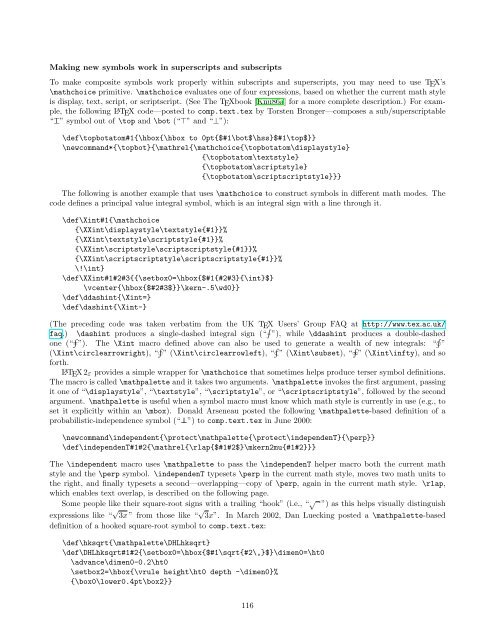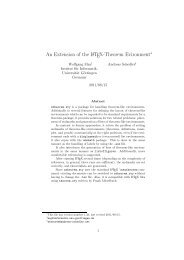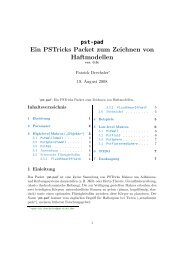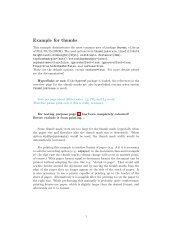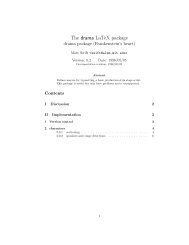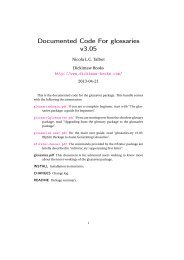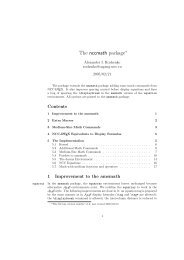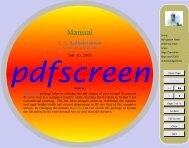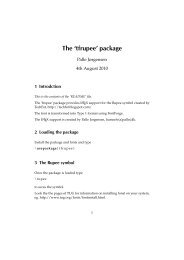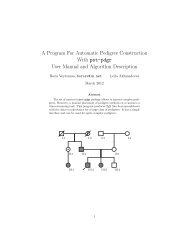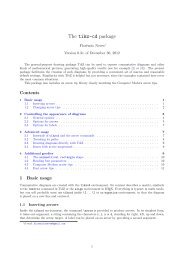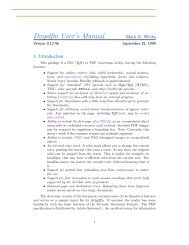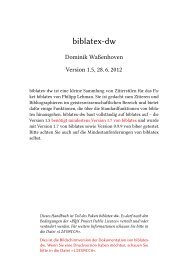The Comprehensive LaTeX Symbol List - CTAN
The Comprehensive LaTeX Symbol List - CTAN
The Comprehensive LaTeX Symbol List - CTAN
You also want an ePaper? Increase the reach of your titles
YUMPU automatically turns print PDFs into web optimized ePapers that Google loves.
Making new symbols work in superscripts and subscripts<br />
To make composite symbols work properly within subscripts and superscripts, you may need to use TEX’s<br />
\mathchoice primitive. \mathchoice evaluates one of four expressions, based on whether the current math style<br />
is display, text, script, or scriptscript. (See <strong>The</strong> TEXbook [Knu86a] for a more complete description.) For example,<br />
the following L ATEX code—posted to comp.text.tex by Torsten Bronger—composes a sub/superscriptable<br />
“⊥⊤” symbol out of \top and \bot (“⊤” and “⊥”):<br />
\def\topbotatom#1{\hbox{\hbox to 0pt{$#1\bot$\hss}$#1\top$}}<br />
\newcommand*{\topbot}{\mathrel{\mathchoice{\topbotatom\displaystyle}<br />
{\topbotatom\textstyle}<br />
{\topbotatom\scriptstyle}<br />
{\topbotatom\scriptscriptstyle}}}<br />
<strong>The</strong> following is another example that uses \mathchoice to construct symbols in different math modes. <strong>The</strong><br />
code defines a principal value integral symbol, which is an integral sign with a line through it.<br />
\def\Xint#1{\mathchoice<br />
{\XXint\displaystyle\textstyle{#1}}%<br />
{\XXint\textstyle\scriptstyle{#1}}%<br />
{\XXint\scriptstyle\scriptscriptstyle{#1}}%<br />
{\XXint\scriptscriptstyle\scriptscriptstyle{#1}}%<br />
\!\int}<br />
\def\XXint#1#2#3{{\setbox0=\hbox{$#1{#2#3}{\int}$}<br />
\vcenter{\hbox{$#2#3$}}\kern-.5\wd0}}<br />
\def\ddashint{\Xint=}<br />
\def\dashint{\Xint-}<br />
(<strong>The</strong> preceding code was taken verbatim from the UK TEX Users’ Group FAQ at http://www.tex.ac.uk/<br />
faq.) \dashint produces a single-dashed integral sign (“−<br />
”), while \ddashint produces a double-dashed <br />
one (“= ”). <strong>The</strong> \Xint macro defined above can also be used to generate a wealth of new integrals: “<br />
”<br />
(\Xint\circlearrowright), “”<br />
(\Xint\circlearrowleft), “⊂”<br />
(\Xint\subset), “∞”<br />
(\Xint\infty), and so<br />
forth.<br />
LATEX 2ε provides a simple wrapper for \mathchoice that sometimes helps produce terser symbol definitions.<br />
<strong>The</strong> macro is called \mathpalette and it takes two arguments. \mathpalette invokes the first argument, passing<br />
it one of “\displaystyle”, “\textstyle”, “\scriptstyle”, or “\scriptscriptstyle”, followed by the second<br />
argument. \mathpalette is useful when a symbol macro must know which math style is currently in use (e.g., to<br />
set it explicitly within an \mbox). Donald Arseneau posted the following \mathpalette-based definition of a<br />
probabilistic-independence symbol (“⊥”) to comp.text.tex in June 2000:<br />
\newcommand\independent{\protect\mathpalette{\protect\independenT}{\perp}}<br />
\def\independenT#1#2{\mathrel{\rlap{$#1#2$}\mkern2mu{#1#2}}}<br />
<strong>The</strong> \independent macro uses \mathpalette to pass the \independenT helper macro both the current math<br />
style and the \perp symbol. \independenT typesets \perp in the current math style, moves two math units to<br />
the right, and finally typesets a second—overlapping—copy of \perp, again in the current math style. \rlap,<br />
which enables text overlap, is described on the following page.<br />
Some people like their square-root signs with a trailing “hook” (i.e., “ √ ”) as this helps visually distinguish<br />
expressions like “ √ 3x ” from those like “ √ 3x”. In March 2002, Dan Luecking posted a \mathpalette-based<br />
definition of a hooked square-root symbol to comp.text.tex:<br />
\def\hksqrt{\mathpalette\DHLhksqrt}<br />
\def\DHLhksqrt#1#2{\setbox0=\hbox{$#1\sqrt{#2\,}$}\dimen0=\ht0<br />
\advance\dimen0-0.2\ht0<br />
\setbox2=\hbox{\vrule height\ht0 depth -\dimen0}%<br />
{\box0\lower0.4pt\box2}}<br />
116


